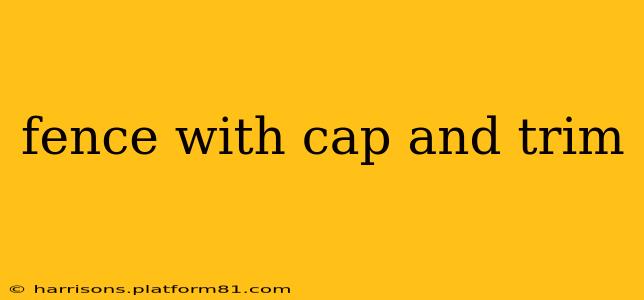A fence is more than just a boundary; it's a statement. Adding a cap and trim elevates your fence from functional to aesthetically pleasing, significantly boosting your property's curb appeal. This comprehensive guide delves into the world of fence caps and trims, exploring their types, benefits, installation, and more. Whether you're a seasoned DIYer or hiring a professional, understanding these elements will help you make informed decisions to create the perfect fence for your needs.
What are Fence Caps and Trims?
Fence caps and trims are finishing elements that protect your fence from the elements while enhancing its appearance. They're separate components:
-
Fence Caps: These are placed on the top of fence rails, acting as a protective barrier against rain, snow, and sun damage. They prevent water from seeping into the wood, reducing rot and extending the fence's lifespan. Beyond protection, caps provide a clean, finished look.
-
Fence Trims: These are decorative pieces applied to the edges of fence panels or posts, adding a polished aesthetic. While primarily decorative, trims can also offer some protection against splintering and weathering.
Types of Fence Caps and Trims
The market offers a wide variety of fence caps and trims to complement different fence styles and materials.
Fence Cap Materials:
- Aluminum: Durable, lightweight, and available in various colors and styles. They're resistant to rust and corrosion.
- Vinyl: Affordable, low-maintenance, and available in a range of colors to match your fence. They are susceptible to cracking under extreme temperatures.
- Wood: Offers a classic, natural look but requires regular maintenance to prevent rot and weathering. Requires sealing and painting for longevity.
- Metal (Steel or Galvanized): Highly durable and long-lasting, offering excellent protection. May require painting to prevent rust.
Fence Trim Materials:
The materials for trims mirror those of caps, with aluminum, vinyl, and wood being the most common choices. Additionally, you might find trims made from composite materials, offering a blend of durability and aesthetics.
Benefits of Using Fence Caps and Trims
Investing in fence caps and trims offers several significant advantages:
- Extended Fence Lifespan: Protection from the elements significantly extends the life of your fence, saving you money on replacements.
- Enhanced Curb Appeal: Caps and trims instantly elevate the look of your fence, adding a touch of elegance and sophistication.
- Increased Property Value: A well-maintained fence with attractive caps and trims can boost your property's value.
- Protection from Damage: Caps prevent water damage, while trims protect against splintering and weathering.
How to Install Fence Caps and Trims
Installing fence caps and trims varies depending on the type of material and fence design. While some DIYers find it manageable, professional installation is often recommended for optimal results and longevity.
General Steps:
- Measure Carefully: Accurate measurements are crucial for a perfect fit.
- Prepare the Fence: Clean the fence surface to ensure proper adhesion.
- Apply Adhesive or Fasteners: Use appropriate adhesive or fasteners based on the cap and trim materials.
- Secure the Caps and Trims: Ensure a tight and secure fit to prevent movement.
- Caulk (If Necessary): Caulking can prevent water from entering between the cap/trim and the fence.
What type of fence cap is best for my fence?
The best type of fence cap depends on your fence material, style, and budget. For example, aluminum caps are ideal for wood fences needing protection and a modern look. Vinyl caps suit vinyl fences for a seamless, maintenance-free finish. Wood caps provide a rustic charm, but demand regular maintenance.
How much do fence caps and trims cost?
The cost varies widely based on the material, style, and length of your fence. Aluminum and vinyl tend to be more affordable than wood or metal. Always obtain multiple quotes from different suppliers to compare pricing and ensure you're getting the best deal.
How long do fence caps last?
The lifespan depends heavily on the material and the climate. Aluminum and vinyl caps generally last for many years, sometimes decades, with minimal maintenance. Wood caps, however, might require replacing or repainting every few years, depending on exposure to the elements.
Are fence caps and trims difficult to install?
The difficulty level depends on your DIY skills and the complexity of your fence. While some simpler caps and trims can be installed by homeowners, more intricate designs might require professional assistance.
By carefully considering your needs and preferences regarding materials, style, and budget, you can choose fence caps and trims that transform your fence into a beautiful and protective asset for years to come. Remember to prioritize quality materials and professional installation whenever possible to ensure a lasting and aesthetically pleasing result.
